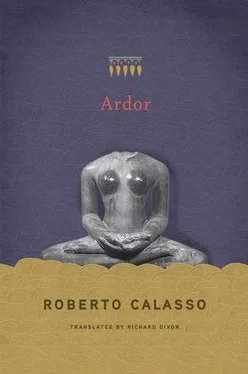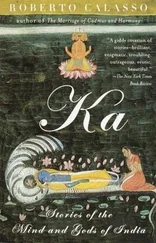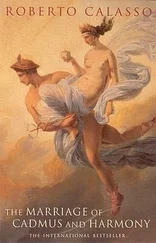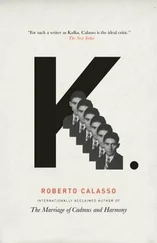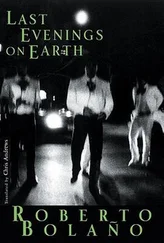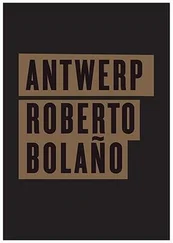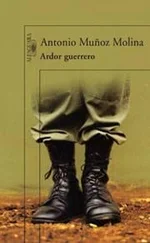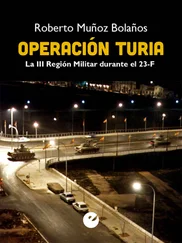There are very few tangible remains of the Vedic period — no buildings survive, no ruins or traces of buildings. At most, a few meager fragments on show in various museums. Instead, they built a Parthenon of words: the Sanskrit language, since saṃskṛta means “perfect.” So said René Daumal.
What was the underlying reason for not wanting to leave any traces? The Westerner, with his usual euhemeristic presumption, would immediately suggest the materials have perished in the tropical climate. But the reason is another — and it is mentioned by the ritualists. If the only event of any importance is the sacrifice, then what should be done with Agni, the altar of fire, once the sacrifice is finished? They replied: “After the completion of the sacrifice, it rises up and enters that bright [sun]. Therefore do not worry if Agni is destroyed, since he is then in that yonder orb.” Every construction is temporary, including the fire altar. It is not a fixed object, but a vehicle. Once the voyage is complete, the vehicle can be destroyed. Thus the Vedic ritualists did not develop the idea of the temple. If such care was given to constructing a bird, it was to make it fly. What remained on earth was an inert shell of dust, dry mud, and bricks. It could be left behind, like a carcass. It would soon be covered once more with vegetation. In the meantime, Agni was in the sun.
* * *
The world was divided into two parts, village and forest. Each followed different rules. What applied to one was not true of the other — and vice versa. All villages would one day be abandoned by their communities, as their seminomadic existence slowly moved on. No sacred places were fixed, umbilical, created once and for all, like temples. The sacred place was the scene for the sacrifice. It had to be chosen each time following set criteria: “As well as being on high ground, that place shall be flat; and as well as being flat, it shall be firm; and as well as being firm, it shall slope eastward, since east is the direction of the gods; or otherwise it should face northward, as north is the direction of men. It shall be raised slightly to the south, because that is the direction of the ancestors. If it had been lower to the south, the sacrificer would have soon passed into the underworld; in this way the sacrificer will live long: that is why it is slightly raised to the south.”
High, flat, firm: these are the first requirements for the place of sacrifice. As if the intention was to define a neutral surface, a backdrop that brings perfect clarity to the action. This is the origin of the stage as a place ready to accommodate all possible meanings. How modern — indeed, the very stage of modernity. The place must, first, be high. Why? Because the gods leave the earth from high ground. And men must imitate them. Then firm. Why? So that it has pratiṣṭhā , “foundation.” Then the place must slope eastward : once again, because east is the direction of the gods. But most important: slightly raised to the south , as if turning away from the direction of the ancestors. The dead lie there and the officiants would quickly slide toward death if the ground were to slope southward. In just a few words, by marking out an ordinary space in the mind’s eye, among brushwood and stones, the blank setting has been described for every action. It is the first locus —and here, at one and the same time, we are told how the world is made, where the gods have gone, and where death lies. What else do we have to know, before any gesture starts? The ritualists were obsessive in their instructions, but never bigoted.
* * *
On the sacrificial ground there is little to see. It is bare, monotonous. But most of what happens cannot be seen: it is a journey into the invisible, fraught with danger, anguish, risk of ambush — a hazardous voyage, like that so loved by Conrad, with a ship ill-matched to face the demands of the forces of nature. And it was one of Conrad’s characters who explained the difference between the carefree manner of people living on land and the precision of anyone living at sea. Only the latter understand that one wrong step, one badly tied knot, could mean disaster. But an error on land can always be put right. The sea alone denies us that “sense of security” which leads to miscalculation.
Though they must have had no great experience of oceans, but rather of majestic rivers, the Vedic people loved referring to an “ocean,” samudrá, salilá , whenever they spoke of anything to do with heaven. For the sky itself was the real ocean, the Milky Way, which continued right onto the earth. And there they found the first image of that continuum from which all ceremonial gestures and words sprang. Like prudent and wary seamen, they thought of that boat, that voyage, during various times of the rituals — for example, at the beginning of a certain chant: “The bahiṣpavamāna chant is in truth a boat heading toward heaven: the priests are its mast, and its oars are the means they use to reach the heavenly world. If one of them is unworthy, he alone will make [the boat] sink: he will make it sink in the same way that someone boarding a boat already full will make it sink. And in fact every sacrifice is a boat sailing heavenward: and so an unworthy priest must be kept away from any sacrifice.”
Though the sacrificial stage, to an outsider, seems like any other place, a tremendous concentration of forces dwells there — and focuses on few objects: they are fragments of the “thunderbolt,” vajra , that supreme and mysterious weapon with which Indra defeated Vṛtra, the enormous monster who kept the waters captive within himself. One object is the wooden sword that the officiants hold. Another is an element of terrifying simplicity: the post. But the cart that transports the rice is also a sacrificial force. And the arrow used by the warriors recalls the breaking of the vajra as it struck Vṛtra. The separation of these objects between brahmins and kṣatriyas , between priests and warriors, is also a shrewd division of powers between the two forms of sovereignty whose balance is always at risk: the brahmins are responsible for the wooden sword and the post; and the kṣatriyas for the cart and the arrow. Two against two: the kṣatriyas closer to everyday life (the cart and the arrow are required by the tribe on the move and in battle); the brahmins more abstract, but none the milder for this (the wooden sword, the solitary post). The most incongruous object, much like a toy — the sphya , the “wooden sword”—is given to the brahmin. But it is also the only one of the four objects that represents the thunderbolt in its totality, as it was once brandished by Indra. Only a brahmin can hold the wooden sword, since it “is the thunderbolt and no man can hold it: so he holds it with the help of the gods.” When one reaches closest proximity to the gods, only a brahmin can act. The story of Indra’s thunderbolt, however, explains why, from the beginning, power is never whole, but is split into two irreducible parts.
* * *
The fabric of relationships between auctoritas and potestas , between spiritual and temporal power, between brahmins and kṣatriyas , between the priest and the king: a perpetual and boundless theme in India from the Ṛgveda to the Mahābhārata (which is all a story of plots and variants within these relationships) and to the Purāṇas (“Antiquities”). Complementary and sometimes hostile relationships: but such conflict was never expressed in the crude terms of a struggle between spirit and force. The brahmins’ ancestors were “seers,” the ṛṣis —and first among them, the Seven Seers, the Saptarṣis, who dwelt in the seven stars of the Great Bear and held terrible destructive power. They were capable of swallowing up, parching, hurling thunderbolts at whole portions of the cosmos. The armies of a king were never as devastating as the tapas , the ardor of a ṛṣi.
Читать дальше
